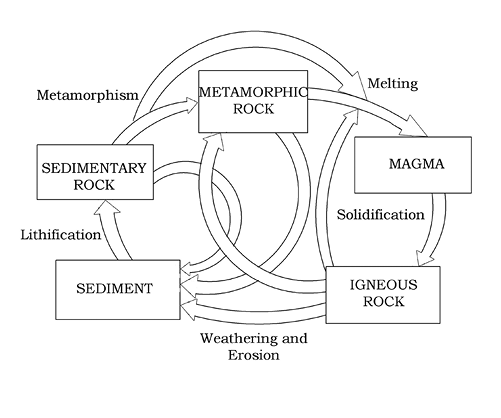Table of Contents
Unit III
Landforms
- Rocks and minerals — major types of rocks and their characteristics
- Landforms and their evolution
- Geomorphic processes — weathering, mass wasting, erosion and deposition; soils — formation

CHAPTER 5
Minerals and Rocks
The earth is composed of various kinds of elements. These elements are in solid form in the outer layer of the earth and in hot and molten form in the interior.
About 98 per cent of the total crust of the earth is composed of eight elements like oxygen, silicon, aluminium, iron, calcium, sodium, potassium and magnesium, and the rest is constituted by titanium, hydrogen, phosphorous, manganese, sulphur, carbon, nickel and other elements.
The elements in the earth’s crust are rarely found exclusively but are usually combined with other elements to make various substances. These substances are recognised as minerals.
Thus, a mineral is a naturally occurring organic and inorganic substance, having an orderly atomic structure and a definite chemical composition and physical properties. A mineral is composed of two or more elements. But, sometimes single element minerals like sulphur, copper, silver, gold, graphite etc. are found.
Though the number of elements making up the lithosphere are limited they are combined in many different ways to make up many varieties of minerals. There are at least 2,000 minerals that have been named and identified in the earth crust; but almost all the commonly occurring ones are related to six major mineral groups that are known as major rock forming minerals.
The basic source of all minerals is the hot magma in the interior of the earth. When magma cools, crystals of minerals appear and a systematic series of minerals are formed in sequence to solidify so as to form rocks. Minerals such as coal, petroleum and natural gas are organic substances found in solid, liquid and gaseous forms respectively.
A brief information about some important minerals in terms of their nature and physical characteristics is given below :
Physical Characteristics
Metallic Minerals
These minerals contain metal content and can be sub-divided into three types:
(i) Precious metals : gold, silver, platinum etc.
(ii) Ferrous metals : iron and other metals often mixed with iron to form various kinds of steel.
(iii) Non-ferrous metals : include metals like copper, lead, zinc, tin, aluminium etc.
Non-Metallic Minerals
These minerals do not contain metal content. Sulphur, phosphates and nitrates are examples of non-metallic minerals. Cement is a mixture of non-metallic minerals.
Rocks
The earth’s crust is composed of rocks. A rock is an aggregate of one or more minerals. Rock may be hard or soft and in varied colours. For example, granite is hard, soapstone is soft. Gabbro is black and quartzite can be milky white. Rocks do not have definite composition of mineral constituents. Feldspar and quartz are the most common minerals found in rocks.
Petrology is science of rocks. A petrologist studies rocks in all their aspects viz., mineral composition, texture, structure, origin, occurrence, alteration and relationship with other rocks.
As there is a close relation between rocks and landforms, rocks and soils, a geographer requires basic knowledge of rocks. There are many different kinds of rocks which are grouped under three families on the basis of their mode of formation. They are: (i) Igneous Rocks — solidified from magma and lava;
(ii) Sedimentary Rocks — the result of deposition of fragments of rocks by exogenous processes; (iii) Metamorphic Rocks — formed out of existing rocks undergoing recrystallisation.
Igneous Rocks
As igneous rocks form out of magma and lava from the interior of the earth, they are known as primary rocks. The igneous rocks (Ignis – in Latin means ‘Fire’) are formed when magma cools and solidifies. You already know what magma is. When magma in its upward movement cools and turns into solid form it is called igneous rock. The process of cooling and solidification can happen in the earth’s crust or on the surface of the earth.
Igneous rocks are classified based on texture. Texture depends upon size and arrangement of grains or other physical conditions of the materials. If molten material is cooled slowly at great depths, mineral grains may be very large. Sudden cooling (at the surface) results in small and smooth grains. Intermediate conditions of cooling would result in intermediate sizes of grains making up igneous rocks. Granite, gabbro, pegmatite, basalt, volcanic breccia and tuff are some of the examples of igneous rocks.
Sedimentary Rocks
The word ‘sedimentary’ is derived from the Latin word sedimentum, which means settling. Rocks (igneous, sedimentary and metamorphic) of the earth’s surface are exposed to denudational agents, and are broken up into various sizes of fragments. Such fragments are transported by different exogenous agencies and deposited. These deposits through compaction turn into rocks. This process is called lithification.
In many sedimentary rocks, the layers of deposits retain their characteristics even after lithification. Hence, we see a number of layers of varying thickness in sedimentary rocks like sandstone, shale etc.
Depending upon the mode of formation, sedimentary rocks are classified into three major groups: (i) mechanically formed — sandstone, conglomerate, limestone, shale, loess etc. are examples; (ii) organically formed—geyserite, chalk, limestone, coal etc. are some examples; (iii) chemically formed — chert, limestone, halite, potash etc. are some examples.
Metamorphic Rocks
The word metamorphic means ‘change of form’. These rocks form under the action of pressure, volume and temperature (PVT) changes. Metamorphism occurs when rocks are forced down to lower levels by tectonic processes or when molten magma rising through the crust comes in contact with the crustal rocks or the underlying rocks are subjected to great amounts of pressure by overlying rocks. Metamorphism is a process by which already consolidated rocks undergo recrystallisation and reorganisation of materials within original rocks.
Mechanical disruption and reorganisation of the original minerals within rocks due to breaking and crushing without any appreciable chemical changes is called dynamic metamorphism. The materials of rocks chemically alter and recrystallise due to thermal metamorphism. There are two types of thermal metamorphism—contact meta-morphism and regional metamorphism. In contact metamorphism the rocks come in contact with hot intruding magma and lava and the rock materials recrystallise under high temperatures. Quite often new materials form out of magma or lava are added to the rocks. In regional metamorphism, rocks undergo recrystallisation due to deformation caused by tectonic shearing together with high temperature or pressure or both. In the process of metamorphism in some rocks grains or minerals get arranged in layers or lines. Such an arrangement of minerals or grains in metamorphic rocks is called foliation or lineation. Sometimes minerals or materials of different groups are arranged into alternating thin to thick layers appearing in light and dark shades. Such a structure in metamorphic rocks is called banding and rocks displaying banding are called banded rocks. Types of metamorphic rocks depend upon original rocks that were subjected to metamorphism. Metamorphic rocks are classified into two major groups — foliated rocks and non-foliated rocks. Gneissoid, granite, syenite, slate, schist, marble, quartzite etc. are some examples of metamorphic rocks.
Rock Cycle
Rocks do not remain in their original form for long but may undergo transformation. Rock cycle is a continuous process through which old rocks are transformed into new ones.
Fig 5.1 : Rock Cycle
Igneous rocks are primary rocks and other rocks (sedimentary and metamorphic) form from these primary rocks. Igneous rocks can be changed into metamorphic rocks. The fragments derived out of igneous and metamorphic rocks form into sedimentary rocks. Sedimentary rocks themselves can turn into fragments and the fragments can be a source for formation of sedimentary rocks. The crustal rocks (igneous, metamorphic and sedimentary) once formed may be carried down into the mantle (interior of the earth) through subduction process (parts or whole of crustal plates going down under another plate in zones of plate convergence) and the same melt down due to increase in temperature in the interior and turn into molten magma, the original source for igneous rocks (Figure 5.1).
EXERCISES
1. Multiple choice questions.
(i) Which one of the following are the two main constituents of granite?
(a) Iron and nickel (c) Silica and aluminium
(b) Iron and silver (d) Iron Oxide and potassium
(ii) Which one of the following is the salient feature of metamorphic rocks?
(a) Changeable (c) Crystalline
(b) Quite (d) Foliation
(iii) Which one of the following is not a single element mineral?
(a) Gold (c) Mica
(b) Silver (d) Graphite
(iv) Which one of the following is the hardest mineral?
(a) Topaz (c) Quartz
(b) Diamond (d) Feldspar
(v) Which one of the following is not a sedimentary rock?
(a) Tillite (c) Breccia
(b) Borax (d) Marble
2. Answer the following questions in about 30 words.
(i) What do you mean by rocks? Name the three major classes of rocks.
(ii) What is an igneous rock? Describe the method of formation and characteristics of igneous rock.
(iii) What is meant by sedimentary rock? Describe the mode of formation of sedimentary rock.
(iv) What relationship explained by rock cycle between the major type of rock?
3. Answer the following questions in about 150 words.
(i) Define the term ‘mineral’ and name the major classes of minerals with their physical characteristics.
(ii) Describe the nature and mode of origin of the chief types of rock at the earth’s crust. How will you distinguish them?
(iii) What are metamorphic rocks? Describe the types of metamorphic rock and how are they formed?
Project Work
Collect different rock samples and try to recognise them from their physical characteristics and identify their family.
